Battle for the South of Russia
The overall situation on the Southern Front in the spring 1919 year
At the beginning of 1919, in connection with the victory in the North Caucasus and the consolidation of a strategic bridgehead in the Kuban and Stavropol regions, the white command planned to deploy troops to Tsaritsyno direction while preparing an attack on Astrakhan with the task of capturing Tsaritsyn and the lower reaches of the Volga River to establish contact with the army Kolchak. This offensive, with simultaneous offensive operations in the Kharkiv and Voronezh sectors, should eventually lead to a strategic strike against the center of Russia.
However, by February - March 1919, the situation on the Southern Front had changed radically in favor of the Red Army. The front line, which was already approaching Voronezh and Kursk, which created the prerequisites for a decisive offensive on the Moscow sector, with the successes of the Red Army in Little Russia and Novorossia, the fall of the Directory and Petlyura regimes, rolled back to Azov. In January-February, 1919 of the year, the third offensive of the Don army of Krasnov against Tsaritsyn choked. The Cossack Republic Krasnov was in crisis. The Don army retreated from Tsaritsyn. The Don units were severely demoralized, decomposed. The front of the White Cossacks collapsed. As a result, the Don Front, which reached Liski, Povorino, Kamyshin and Tsaritsyn, was completely upset, and retreated to the North Donets and Sal. The Red Army, without encountering serious resistance, advanced on Novocherkassk. The Don Army, which had 1919 at the beginning of the year before 50, had thousands of bayonets and sabers, retreated to the Donets with 15 thousands of fighters. The Don government requested urgent assistance from Denikin. At the same time, the government of Krasnov conducted negotiations with representatives of the Entente, but the Westernizers only made promises, there was no real help.
After the withdrawal of the German invaders, the left flank of the Don Army was opened. The front line immediately increased by 600 kilometers. Moreover, this breach fell on the Bolshevik-minded coal basin of Donbass, where the Red Army was actively supported by local troops. The White Command sent the May-Mayevsky Infantry Division to help the Krasnov troops. The Don Mai-Mayevsky detachment occupied the area from Mariupol to Yuzovka. It was an experienced commander, loved by his soldiers. As a result, a small detachment of Mai-Mayevsky, now advancing, now retreating, constantly maneuvering, and successfully withstood the pressure of the considerably superior forces of the Reds - the left wing of the Ukrainian and the right Southern Fronts. At the same time, Denikin could not isolate additional forces. The White Command tried to create new powerful formations in the South of Russia, sending detachments to the Crimea, Northern Tavria and Odessa as the backbone of the new formations.
In addition, at this time in the North Caucasus, the last fierce battles were raging in the Terek region, in the region of Grozny and Vladikavkaz. Immediately after the capture of Vladikavkaz (10 in February 1919), the trains of the Volunteer Army went north - the Caucasian division of General Shkuro was at the forefront, followed by the 1-I Kuban division of the Corps of General Pokrovsky, the 1-I Terek division and other units. Thus, the white command was forced to change the original plan of attack by the main forces against Tsaritsyn in order to preserve the Don region and its positions in the Donbas. At the same time maintaining the possibility of an attack on the Tsaritsyn direction.
In the meantime, the Don changed power. Krasnov due to failures at the front and the former pro-German orientation became an inconvenient figure. He was replaced by Bogaevsky. The advance of the red on the Don gradually slowed down. In the second half of February, the Don divisions recovered somewhat and launched a series of counterattacks in red. Red rejected for the Donets. The appearance of the White Guard reinforcements raised the morale of the Don Cossacks. The formation of new volunteer units began. In addition, nature has helped. After a harsh winter, strong thaws and an early, stormy spring began. Roads turned into swamps. Rivers spilled, becoming almost insurmountable obstacles. As a result, the front stabilized for a while.
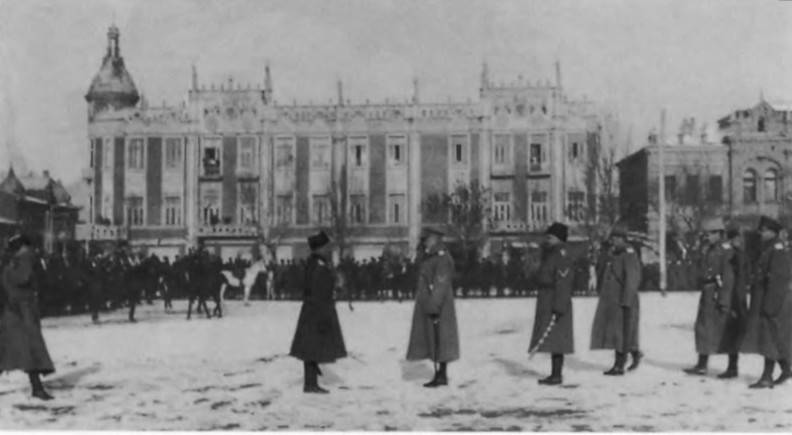
Front line to March 1919 of the year
The Don troops of General Mamontov (5-6 thousand people), located between the Salom and Manych rivers, were located in Tsaritsyn. Behind Manych concentrated a group under the command of General Kutepov (about 10-11 thousand people), partly in the area of the Grand-Ducal, partly to the south, at Divnoye - Priyutny. In the center, beyond the Donets, the main forces of the Don Army, headed by General Sidorin (12-13 thousand soldiers), were located. On the left flank of the Don Army, on the Luhansk direction, there was a group of General Konovalov. In the area of Aleksandro-Grushevskogo, north of Novocherkassk, the divisions of General Pokrovsky and Shkuro gathered, which were transferred to the Lugansk direction.
On the right flank of the Southern Front, from the Kolpakovo station on Volnovakha and Mariupol, units of the Caucasian Volunteer Army (12 thousand people) were located. Since the North Caucasus connected only one railway with the Donets Basin, the concentration of troops was slow. Thus, on VSYuR there were 750 versts of the Southern front around 45 thousand bayonets and sabers. The most combat-ready were the troops on the left wing — units of the Caucasian Volunteer Army and Don cavalry divisions in the Luhansk sector.
2 March 1919 of the year white troops received the following tasks: to continue the transfer of troops from the Caucasus to the Donets Basin; conduct an active defense in the western part of the Donetsk basin, as well as at Donets and Don, with the right wing of the Caucasian Volunteer Army and the left wing of the Don Army to strike at the main Red forces on the Debaltseve-Lugansk front; group of general Kutepov, after concentration, together with the right wing of the Don army to advance in the direction of Tsaritsyn.
The Red Army acted on the southern strategic direction by the Soviet armies of the Southern Front under the command of Vladimir Gittis (he ended the World War by a colonel and in October went over to the side of Soviet power) and the Ukrainian Front under the command of Vladimir Antonov-Ovsienko. After the unsuccessful offensive on Novocherkassk from the northeast 8-th and 9-th Red Army, the Soviet command changed the plan and began to regroup.
In March, 1919, the new offensive of the Red Army began. Along the railway line Tsaritsyn - Tikhoretskaya advanced XOR units of the 10 Army of Egorov (23, thousand bayonets and sabers) advanced. It also included a group of Reds, which previously acted in the direction of Stavropol. On the Don from Chir to the mouth of the Donets and on the Donets there was the Knyagnitsky 9 Army (thous. 28 thousand). To the west, moving from the Voronezh direction to the Luhansk area, the troops of the 8 Army of Tukhachevsky (about 27 thousand people) were stationed. From mid-March, HNXIN led the 8 Army. To the south to Yuzovka there was a section of the 13 Army of Kozhevnikov (about 20-25 thousand people), created in March on the basis of a group of troops of the Donetsk direction.
In the area of Yuzovka there was a junction of the Southern and Ukrainian Red Fronts. On the left wing of the Ukrainian front, the 2-I Ukrainian army was deployed under the command of Skachko (later 14-I army), which was created from units of the group of troops of Kharkov direction, insurgent detachments of ataman Makhno, Opanasyuk and others (3-I and 7-I Ukrainian divisions ). This group, which had 20 -25 thousand fighters, was located the main forces against Yuzovka - Volnovakhi. Then along the line Berdyansk - Melitopol - Perekop there was a special Crimean group.
Thus, against the White Guards and White Cossacks of the All-Soviet Frontal South Front (plus some of the forces of the Ukrainian Front) the Reds had about 130 bayonets and sabers. The Red forces had two main groups: in the Tsaritsyn sector, the strong 10 army, and on the Lugansk-Volnovakh line, the 8, 13, and most of the 2 of the Ukrainian army. The Soviet command planned to destroy the enemy group covering the Donets Basin. For this: in the center of the Soviet troops held the front, on the flanks inflicted powerful blows. 8-I and 13-I armies attacked in the Donbas, cutting off parts of the Volunteer Army from the White Cossacks, and the 10-Army from Tsaritsyn to Tikhoretskaya to cut off the Don from the Kuban.
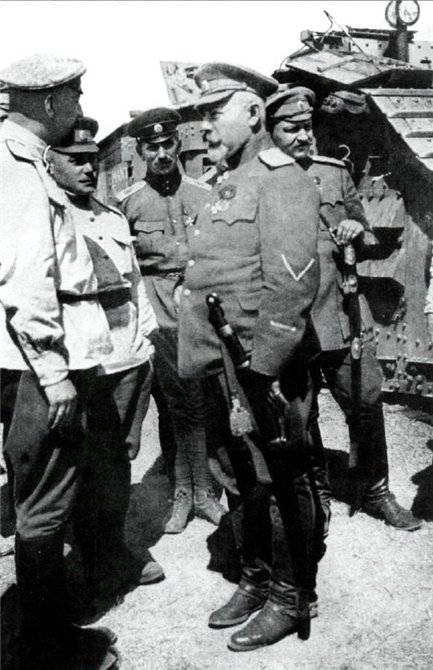
Spring Battle on the Southern Front
As a result of the plans of the white and red command, the regrouping of forces, in March 1919, in the south of Russia a fierce oncoming battle began. In the area between the Sea of Azov and Donets, the Soviet armies, which had a significant numerical advantage, launched an offensive. In the area between the upper Mius and Donets, counter-fighting between the 8 army and part of the 13 and the white strike group seethed. Here were the best parts of Denikin’s army: the Don Corps of Konovalov, the Kuban Corps of Pokrovsky, and the equestrian corps of Shkuro. That is, the selective units of the White Army fought here: Drozdovsky, Markovsky, Kornilovsky regiments, Kuban cavalry Skins. He led this group Wrangel, who distinguished himself in battles in the North Caucasus.
The troops of the 8 and 13 of the Red armies had a numerical superiority, the plan of the operation was good. However, the whites, constantly maneuvering, stood up firmly and put up strong counterattacks in red. The same white parts were transferred from plot to plot. There was no one to replace them, but they held out. Both sides suffered heavy losses. The battle was very tense. Wrangel, who went through two wars and became a talented commander of the Civil War, received a severe nervous breakdown and took sick leave. He was replaced by Yuzefovich.
In the western sector of the front, the corps of General May-Mayevsky led the “railway” war with the same great tension. In the conditions of great superiority of the forces of the Reds, the white general applied a special tactic. Using a dense network of railways in the area, May-Mayevsky occupied small detachments of the main points on the front line and located in the rear at the junction stations of armored trains and mobile reserves. They were transferred to dangerous areas and could be taken back on the same day and transferred to another threatened area of the front. The enemy had the impression that White had significant forces and reserves in all directions, although these were the same parts. Thus, the offensive of the Red Army, which swept over Northern Tavria and Donbass, was repelled.
In the middle of March, 1919, after the regrouping of new forces and reinforcements, the Red Army again launched an offensive in the direction of Debaltsev, Grishin and Mariupol. Caucasian Volunteer Army was pushed. The Reds took Yuzovo, Dolya, Volnovakha and Mariupol. Corps Shkuro, who took Debaltseve 17, was sent to the raid on the enemy's rear. Within two weeks, from March 17 to April 2, the Kuban parts of the Shkuro passed from Gorlovka to the Sea of Azov. White made a panic in the rear of the Reds, chopped, scattered and captured several thousand people, took large trophies, including armored trains. Between Volnovakha and Mariupol, the body of Shkuro was smashed by one of the groups of Makhno, who fled, throwing weapon and various property. As the cavalry moved, and at the same time with it, other units of the whites went over to the offensive and restored their previous positions.
In many ways, the success of the raid of Shkuro and Denikin’s army as a whole was due to the fact that the 13 Army began to decompose, and the troops of Makhno and other “Ukrainian” atamans had low combat capability, they preferred to avoid direct combat. The quick victories of the Reds in the Ukraine and Novorossia over the Petliurists led to the “Ukrainian” detachments of various troupes and atamans joining the ranks of the Red Army. In fact, these were gangs that were reformed into Soviet units. However, they remained semi-gangster, partisan detachments, with low discipline, anarchy and atamanism. Such units could not withstand the selective volunteer regiments of the whites and White Cossacks, did not hold the front, ran and deserted, and with their existence disintegrated other Soviet units. As a result, the number of deserters in February - April 1919 of the year on the Southern Front reached 15 - 23%.
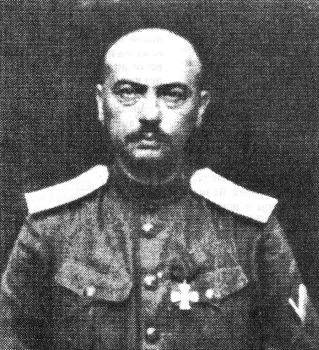
Chief of Staff of the Caucasian Volunteer Army Yakov Davydovich Yuzefovich
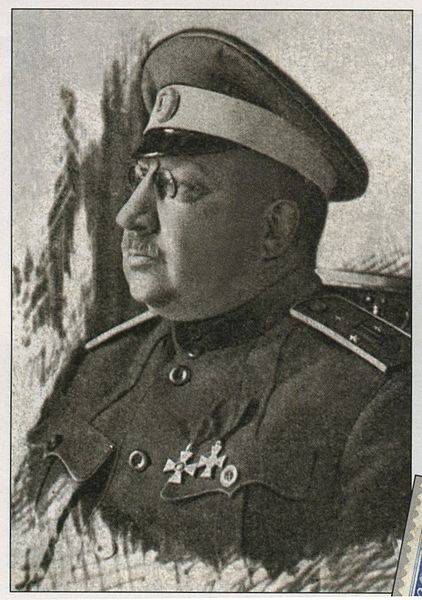
Central front
In the center, the front remained more or less calm. This allowed the Don Army, in which after the defeat, about 15 thousand people remained, to recover and join the ranks. 9-I red army several times tried to check the enemy's defense on the Donets, but all its attacks were repulsed by the Don. At the end of March, the Reds attacked here with large forces, crossing the river simultaneously at Kamenskaya and Ust-Belokalitvenskaya. Don units were rejected. The situation was straightened by the equestrian corps of Colonel Kalinin, redeployed from the Luhansk direction, who defeated and left the Reds near Kamenskaya. Then he turned to Kalitva and, together with the corps of General Semiletov, successfully attacked here. In the first half of April, units of the 9 Army tried to force the river in the lower reaches of the Donets, but without success. As a result, there was a lull in this sector of the front.
Simultaneously with the attack at Kamensky, the red units launched an offensive on the Luhansk direction. However, the Kalinin and Shkuro corps, which were transferred here, together with other left-flank units of the Don Army, in 20-s of April broke the enemy and threw him out of the Belaya River.
Thus, by the middle of April 1919, a month and a half after the start of the Red Army offensive and after fierce fighting, especially on the western flank of the front, the Caucasian Volunteer and Don Army armies retained their positions, retaining the Donbass and the Donetsk bridgehead. At the same time, the Don Army was able to partially recover. The Don command skillfully used its best units, maneuvering them at the front, and at the same time led to the reorganization and restoration of the army. Here the White Cascades were helped by a favorable factor. In the rear of the Reds, the Cossacks of the Upper Don Region revolted (the Verkhnya Uprising). This uprising distracted part of the forces of the Red Army, which could act against the whites.
To be continued ...
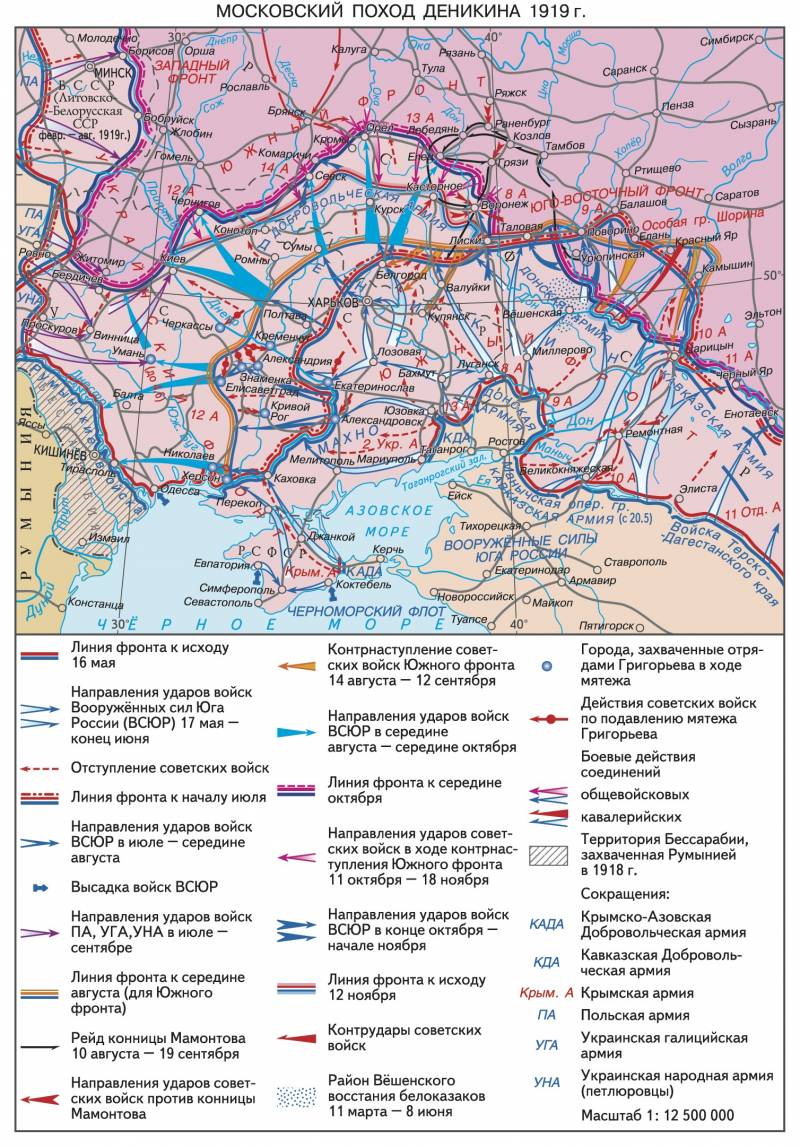
Information